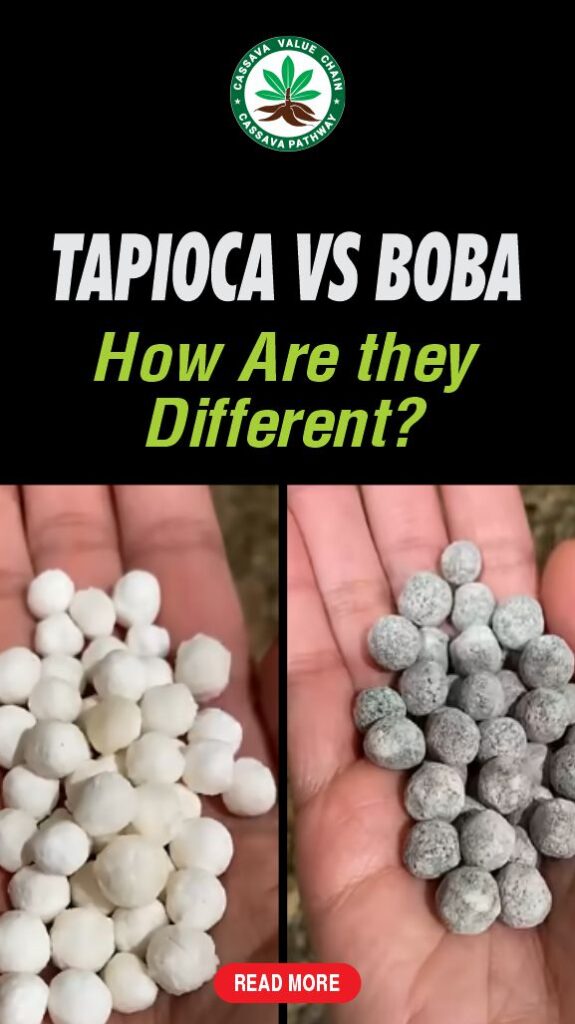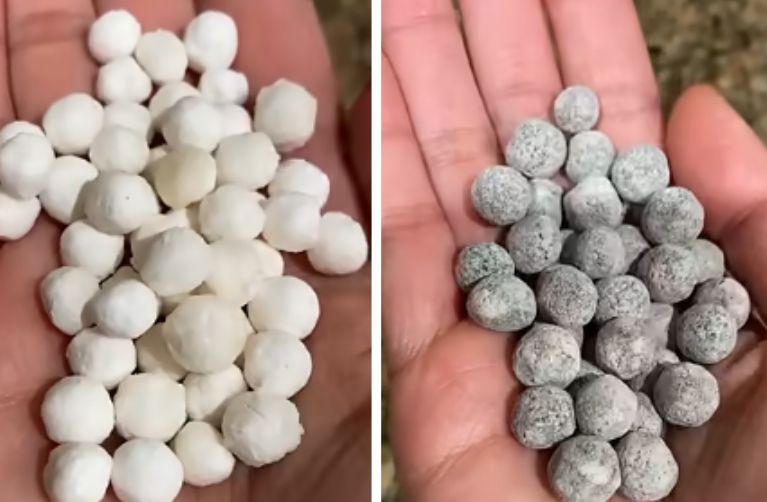Tapioca vs Boba, how are they different? These two aren’t the same! Tapioca is a starch, while boba refers to the chewy pearls in bubble tea. Discover their differences, uses, and which one suits your needs.
You’ve probably heard people use “tapioca” and “boba” as if they’re the same thing.
But they’re not. Tapioca is a starch extracted from the cassava root, while boba refers to the chewy pearls you find in bubble tea.
The confusion comes from the fact that traditional boba pearls are made from tapioca starch.
However, not all boba is made from tapioca, and tapioca has many other uses beyond bubble tea.
If you love bubble tea, enjoy tapioca-based desserts, or just want to use the right terms, understanding the difference matters.
This guide breaks down what sets tapioca and boba apart, their uses, textures, and how they’re prepared.
By the end, you’ll know exactly which one to use for different recipes.
Related: Tapioca vs Cassava

Table of Contents
- What is Tapioca and Boba?
- Tapioca vs Boba: The Differences
- Tapioca Pearls vs Boba Pearls: A Closer Look
- Which One Should You Use?
- Common Questions About Tapioca and Boba
- How Tapioca and Boba Are Used Around the World
What is Tapioca and Boba?
Tapioca
Tapioca comes from the cassava root, a tuber native to South America but widely cultivated in Africa and Asia.
The plant is processed to remove toxins, leaving behind pure starch.
This starch is highly versatile and appears in different forms: flour, flakes, pearls, and even sticks.
Since it’s gluten-free and neutral in taste, it works well in many dishes.
Forms of Tapioca
- Tapioca Starch: A fine, white powder used in baking, thickening sauces, and making gluten-free products. It creates a smooth texture in soups, puddings, and gravies.
- Tapioca Flour: Often confused with starch, but slightly coarser. It works well in gluten-free baking, giving bread and pastries a chewy texture.
- Tapioca Pearls: Small, round balls that expand when boiled. They are commonly used in bubble tea, puddings, and traditional desserts.
- Tapioca Flakes: Less common but useful in thickening soups and stews.
- Tapioca Sticks: Found in Asian markets, these require soaking and cooking before use in desserts.
Tapioca is naturally bland, so it absorbs flavors well when cooked with sweeteners, spices, or sauces.
Related: Tapioca Pudding vs Rice Pudding
What is Boba?
Boba refers specifically to the chewy pearls used in bubble tea. The term originated in Taiwan in the 1980s when the drink became popular.
Traditionally, these pearls are made from tapioca starch, giving them their distinct chewiness.
However, newer varieties of boba include popping boba and crystal boba, each with different textures and ingredients.
Types of Boba
- Tapioca Boba: The most common type, made from tapioca starch and brown sugar. These pearls turn dark and chewy when cooked.
- Popping Boba: Filled with fruit juice that bursts when you bite into them. These are made using molecular gastronomy techniques.
- Crystal Boba: Made from agar or konjac, giving them a jelly-like texture. They are softer than traditional boba and come in various flavors.
- Mini Boba: Smaller versions of tapioca pearls, used in teas and desserts for a different texture experience.
Boba pearls are usually cooked in boiling water and then soaked in a sugar syrup to give them a sweet, rich flavor. Without the syrup, they remain relatively tasteless.
Related: Troubleshooting Tapioca Balls
Tapioca vs Boba: The Differences
Tapioca and boba are related but not interchangeable. Here’s how they differ:
- Material: Tapioca is a starch extracted from cassava. Boba refers to pearls, which are usually made from tapioca but can also be made from other ingredients.
- Usage: Tapioca is used in cooking and baking, while boba is mainly used in bubble tea.
- Texture: Tapioca pearls have a chewy texture when cooked. Boba can be chewy, bursting, or jelly-like, depending on the type.
- Sweetening: Tapioca pearls are naturally bland. Boba pearls are typically sweetened by soaking them in syrup.
Think of it this way: Tapioca is an ingredient, while boba is a finished product used in drinks.
Related: What Are Tapioca Balls?
Tapioca Pearls vs Boba Pearls: A Closer Look
Tapioca pearls and boba pearls are closely related, but there are subtle differences.
Tapioca pearls start as white or translucent balls before they are cooked. When boiled with brown sugar, they become the dark, sweet, chewy pearls commonly found in bubble tea.
How Tapioca Pearls Become Boba
- Boil water and add dry tapioca pearls.
- Stir until they float and cook for about 20-30 minutes.
- Let them sit in hot water for another 15-20 minutes.
- Rinse with cold water and soak in brown sugar syrup.
Without this cooking and soaking process, tapioca pearls remain flavorless and firm. The syrup gives them their signature taste and glossy appearance.
Related: Cornstarch and Tapioca: How are they Different?
Which One Should You Use?
It depends on your purpose. Here’s a simple guide:
- For Bubble Tea: Use tapioca boba or popping boba.
- For Puddings and Desserts: Tapioca pearls work best.
- For Thickening: Tapioca starch or flour is ideal.
- For Gluten-Free Baking: Use tapioca flour as a wheat flour substitute.
Related: Tapioca vs Arrowroot: How to Identify Both
Common Questions About Tapioca and Boba
Is Boba Always Made from Tapioca?
No. While traditional boba is made from tapioca starch, popping boba and crystal boba are made from other ingredients like fruit juice, agar, or konjac.
Are Tapioca Pearls and Boba Pearls the Same?
Not exactly. All boba pearls start as tapioca pearls, but they are cooked and sweetened to be used in bubble tea.
Can You Eat Tapioca Pearls Without Making Bubble Tea?
Yes. They are often used in puddings, Brazilian pão de queijo (cheese bread), and other desserts.
What Gives Boba Pearls Their Chewiness?
Tapioca starch is responsible for the chewy texture. The cooking and soaking process enhances this consistency.
Are There Health Concerns With Boba or Tapioca?
Both are high in carbohydrates and provide quick energy. However, boba pearls in bubble tea contain added sugar, which can increase calorie intake.
Recommended: How to Make Boba Pearls Without Tapioca Starch
How Tapioca and Boba Are Used Around the World
Tapioca is a staple ingredient in many cultures:
- In Brazil: Used in pão de queijo, a chewy cheese bread made with tapioca flour.
- In Southeast Asia: Found in sweet soups and coconut-based desserts.
- In Africa: Processed into cassava flour, which is used for making fufu and other starchy dishes.
- In India: Used to make sabudana khichdi, a fasting dish prepared with spiced tapioca pearls.
Boba, on the other hand, is mainly associated with Taiwan, where bubble tea originated. However, it has gained worldwide popularity and is now available in cafes globally.
Related: Tapioca Boba vs Popping Boba
Final Thoughts
Tapioca and boba may look similar, but they serve different purposes. Tapioca is a starch, while boba refers to chewy pearls used in bubble tea.
If you’re making bubble tea, you’ll want boba pearls, which are usually made from tapioca starch.
But tapioca itself has many other uses, it thickens soups, enhances gluten-free baking, and creates creamy desserts.
Understanding the difference helps you choose the right ingredient for your needs. Whether you’re cooking with tapioca starch or enjoying a refreshing bubble tea, you now know what sets them apart.
Next time someone mixes up tapioca and boba, you’ll have the answer. Want to try making your own boba or tapioca-based dessert? Now’s the perfect time to experiment!

Chimeremeze Emeh is a writer and researcher passionate about Africa’s most transformative root crop—cassava. Through his work at cassavavaluechain.com, he explores the entire cassava industry, from cultivation and processing to its diverse applications in food, health, and industrial use.
He also writes for palmoilpalm.com, where he shares his extensive experience and deep-rooted knowledge of palm oil, covering red palm oil, palm kernel oil, and refined products. His work there reflects his lifelong connection to agriculture and his commitment to promoting sustainable value chains in Africa.
Driven by curiosity and purpose, Chimeremeze aims to shed light on how cassava continues to empower communities, strengthen food systems, and link traditional farming wisdom with modern innovation.

